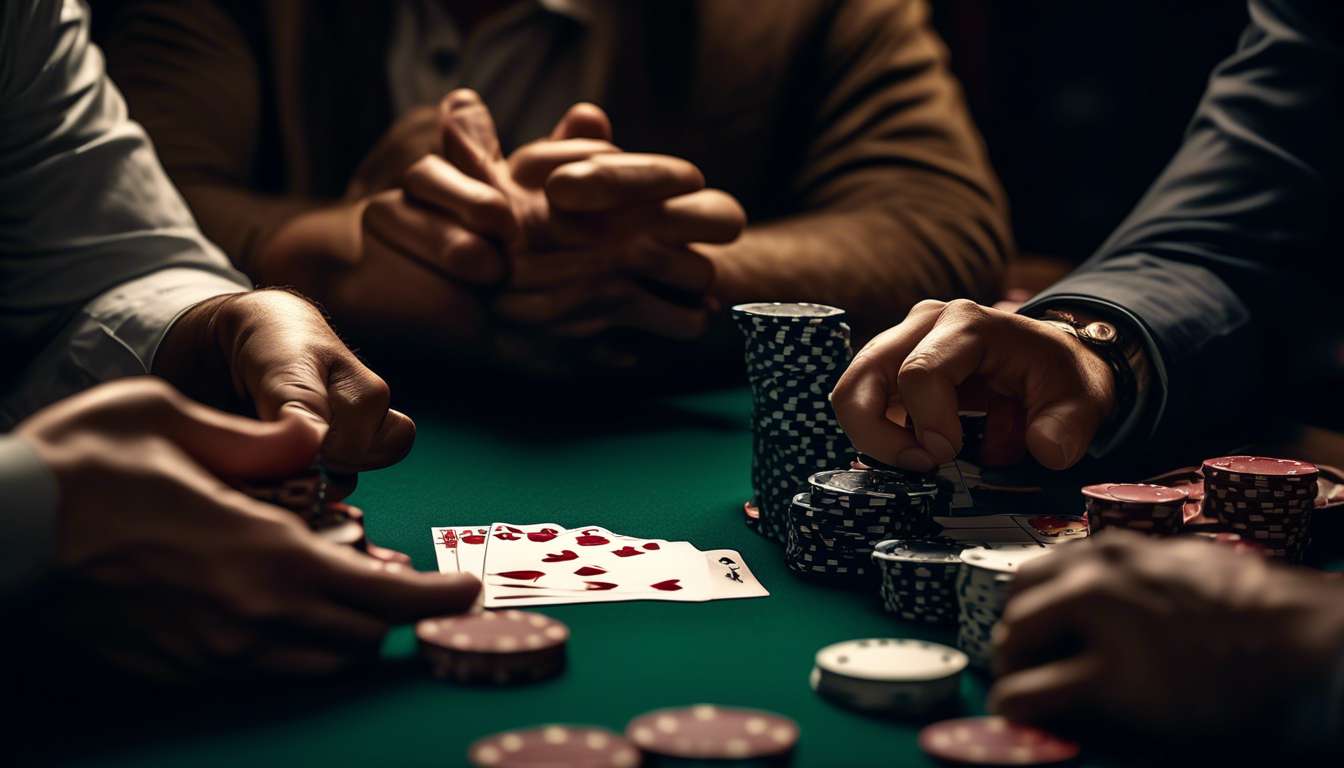In the exhilarating world of poker, every hand is an opportunity, and every player is a potential adversary. Bluffing is one of the most exhilarating aspects of the game, and mastering this skill can differentiate between a triumphant win and a crushing defeat.
Bluffing Techniques:
- Techniques are designed to deceive opponents.
- Turn seemingly weak hands into powerful tools of persuasion.
Key Elements of Bluffing:
-
Timing:
- Knowing when to bluff is crucial.
- Misjudging the timing can lead to revealing too much or too little.
-
Reading Opponents’ Tells:
- Observing opponents’ behaviors and reactions can provide insights.
- Identifying tells helps in predicting opponents’ hands and decisions.
-
Maintaining a Confident Demeanor:
- Confidence can make bluffs more believable.
- A steady demeanor helps avoid giving away tells.
By understanding these strategies, we aim to refine our bluffing skills, ensuring we remain unpredictable and formidable at the table.
Join us on this journey to enhance our poker prowess, where the line between truth and fiction blurs, and success hinges on our ability to deceive with finesse.
Mastering the Art of Bluffing
Mastering the art of bluffing requires us to understand our opponents’ tendencies and leverage them to our advantage. Bluffing isn’t just about deception—it’s a strategic dance.
Our goal is to craft a convincing narrative that makes our opponents believe in the reality we present, even if it’s far from the truth. By observing behaviors and betting patterns, we can anticipate their moves and adjust our strategy accordingly.
In our shared pursuit of poker excellence, we rely on a keen sense of psychology. We recognize that each player at the table has unique motivations and fears. By tapping into these psychological cues, we create opportunities to execute successful bluffs.
- It’s not about individual prowess.
- It’s about fostering a deeper connection with the game and each other.
Together, we’ll refine our bluffing techniques, ensuring we all feel like integral parts of a winning team, elevating our collective poker experience.
Psychological Aspects of Bluffing
Understanding the psychological aspects of bluffing allows us to manipulate perceptions and influence our opponents’ decisions effectively. It’s not just about the cards we hold; it’s about crafting a strategy that plays on the minds of those across the table.
When we bluff, we’re engaging in a psychological dance, where reading opponents’ behaviors and emotions becomes crucial. We share a common goal: to create doubt and uncertainty in their minds, making them question their own strategies.
The psychology of bluffing taps into our ability to project confidence, even when holding a weak hand. By understanding human behavior, we can exploit tells and body language, subtly influencing our opponents. We become part of a community that thrives on intuition and observation, using these skills to our advantage.
In poker, we’re united by the thrill of the game and the shared understanding that bluffing is an art form. Together, we navigate the psychological landscape, transforming our strategies into successful outcomes.
Bluffing Frequency and Patterns
We often wonder how frequently we should bluff and what patterns will make our bluffs more effective. In our poker community, understanding the balance between bluffing too much and too little is crucial for our strategy.
If we bluff too often:
- Our opponents will catch on quickly.
If we rarely bluff:
- We’re missing out on potential wins.
It’s all about finding the sweet spot that keeps us unpredictable and maintains the psychological edge.
By varying our bluffing frequency, we can create patterns that are hard for others to read. This doesn’t just keep them guessing; it roots us deeper into the game’s psychology.
When our opponents can’t predict our moves, we gain an advantage. It’s like weaving a web of uncertainty where our strategic bluffs become powerful tools in our arsenal.
In our quest for poker mastery, let’s work together to refine our bluffing strategies and patterns, ensuring our place at the table is not just occupied but commanding.
Strategic Bluffing in Poker Games
In poker, strategic bluffing is an art used to influence opponents’ decisions and tip the odds in our favor. Our community of poker enthusiasts thrives on the shared understanding that bluffing is both a strategy and a test of psychology.
Recognizing Effective Bluffing Moments:
- Consider the table’s dynamic.
- Analyze opponents’ tendencies.
By studying our opponents’ behaviors and betting patterns, we craft a strategy that makes our bluffs believable. If we consistently play predictably, our bluffs won’t hold water. Instead, we mix our playstyle, incorporating well-timed bluffs that keep others guessing.
We’re not just playing cards; we’re engaging in a psychological battle, gauging reactions and adjusting our strategy accordingly.
Community and Mastery:
As a poker community, achieving success through strategic bluffing connects us, fostering a sense of camaraderie and belonging. Together, we refine our skills, understanding that the true essence of poker lies in mastering the balance between strategy and psychology.
Enhancing Bluffing with Body Language
Mastering Body Language in Poker
We can amplify the impact of our bluffs by mastering subtle shifts in body language that mislead opponents without uttering a word. By integrating psychology into our strategy, we create an aura of confidence while masking any underlying uncertainty.
Key Elements of Body Language:
-
Facial Expressions: A calm demeanor can suggest a strong hand, encouraging others to fold.
-
Eye Contact:
- A steady gaze might project dominance.
- A fleeting glance could suggest vulnerability.
Community Insights
In our community of poker enthusiasts, understanding these cues strengthens our collective strategy. A relaxed posture can imply comfort and control, persuading opponents to doubt their own hands.
Chip and Card Handling:
- The way we handle our chips and cards can either convey assertiveness or hesitation, influencing others’ perceptions.
Collective Strategy Development
Together, we sharpen our skills, embracing the psychology of bluffing to outwit competitors. By reading and sending the right signals, we align our body language with our strategic goals, creating a unified front at the table.
Calculated Risks in Bluffing
Taking calculated risks at the poker table requires us to weigh potential gains against possible losses, ensuring our bluffs are both strategic and effective.
As a community of poker enthusiasts, we know that the art of bluffing isn’t just about deception; it’s about understanding the intricate balance between risk and reward. Our strategy must account for:
- The psychology of our opponents
- The dynamics of the game itself
By observing our opponents’ tendencies and reading their psychological tells, we can craft bluffs that are more likely to succeed. It’s essential to consider various factors, such as:
- The current state of the game
- Our opponents’ likely reactions
We don’t want to take unnecessary risks, but we also don’t want to miss opportunities where a well-timed bluff could shift momentum in our favor.
Together, by embracing calculated risks, we enhance our collective experience and elevate our game, creating an atmosphere where every hand becomes an exciting challenge.
Bluffing in Different Poker Variants
In exploring various poker variants, we find that each game presents unique opportunities and challenges for executing successful bluffs.
Texas Hold’em:
- Our strategy often leverages the community cards.
- It’s crucial to understand our opponents’ psychology by gauging their reactions to various board textures.
- This allows us to create a convincing narrative for our bluffs.
Omaha:
- With more hole cards, bluffing demands a different approach.
- We must consider a wider range of possible hands our opponents might hold.
- This makes bluffing a more complex endeavor compared to Texas Hold’em.
Stud Games:
- Cards are revealed gradually, allowing us to craft our bluff by monitoring the visible cards and our opponents’ betting patterns.
- The key lies in utilizing the open cards to create a believable story.
Razz:
- In this game, where low hands win, our strategy shifts.
- Bluffing involves convincing others that we have a stronger low hand than we actually do.
Embracing these nuances fosters a sense of camaraderie among us, as we refine our skills together.
Practicing Bluffing for Success
Mastering Bluffing through Practice
We can master bluffing by consistently practicing in low-stakes games, where the pressure is minimal and learning opportunities abound. These environments allow us to test different strategies without the fear of significant loss, making it easier to focus on refining our skills.
By doing this, we build a sense of camaraderie with fellow players who are also honing their bluffing techniques. Together, we can exchange insights and learn from each other’s experiences.
Understanding the Psychology of Bluffing
Understanding the psychology behind bluffing is crucial. We must pay attention to our opponents’ behaviors and tendencies, learning to:
- Spot their tells
- Conceal our own
This psychological awareness helps us determine:
- The best moments to bluff
- When to hold back
Building Confidence and Community
As we practice, our confidence grows, creating a sense of belonging in the poker community. We’re not just playing cards; we’re engaging in a complex dance of strategy and psychology that unites us all.
Conclusion
Let’s sharpen our skills together and achieve success at the table.
What are the common tells of an inexperienced bluffer in poker?
When we’re at the table, spotting an inexperienced bluffer in poker becomes easier with certain tells.
Common signs include:
- Nervous gestures like fidgeting or sweating
- Avoiding eye contact
- Acting too quickly or too slowly, showing inconsistency in gameplay
These behaviors give us clues to make better decisions during the game and capitalize on their weaknesses.
How does the timing of a bluff impact its effectiveness in a game?
Timing and Effectiveness of a Bluff
Importance of Timing:
Timing plays a crucial role in the effectiveness of a bluff. When executed correctly, a well-timed bluff can catch opponents off guard and lead to a successful outcome.
Key Considerations for Timing a Bluff:
-
Flow of the Game:
- Pay attention to the pace and dynamics of the game.
- Identify moments when opponents are least expecting a bluff.
-
Opponents’ Behaviors:
- Observe opponents for any tells or patterns in their play.
- Use their predictability to your advantage.
-
Overall Situation:
- Consider the stakes and potential outcomes.
- Assess if the current situation is conducive to a bluff.
Strategic Execution:
By waiting for the right moment to strike, we increase our chances of bluffing successfully and winning the hand.
Can bluffing be effectively used in online poker where physical tells are absent?
Bluffing in Online Poker
Absolutely, bluffing can still be a powerful tool in online poker games. While physical tells may be absent, players can still utilize other strategies to deceive opponents effectively.
Key Bluffing Strategies:
-
Timing:
- Observe how much time players take to make decisions. Quick decisions can indicate confidence, while prolonged thought might suggest uncertainty.
-
Bet Sizing:
- Use bet size to create a story. Consistent betting patterns can mislead opponents about the strength of your hand.
-
Patterns:
- Pay attention to opponents’ betting habits over time. Recognizing their patterns can help you identify the best moments to bluff.
Additional Considerations:
- Board Texture:
- Evaluate the community cards to determine if they support a plausible strong hand, which can make your bluff more convincing.
Online poker requires a different approach, but with practice and strategy, bluffing can certainly be a successful tactic in your games.
Conclusion
In conclusion, mastering bluffing techniques in poker requires a combination of skill, psychology, and strategy.
By understanding the art of bluffing, recognizing patterns, and utilizing body language, you can enhance your gameplay and increase your chances of success.
Key Steps to Improve Bluffing:
- Understand the art of bluffing.
- Recognize patterns in opponents.
- Utilize effective body language.
Remember to take calculated risks and practice regularly to refine your bluffing abilities.
With dedication and practice, you can become a formidable player at the poker table.
Good luck, and may your bluffs always be successful!

